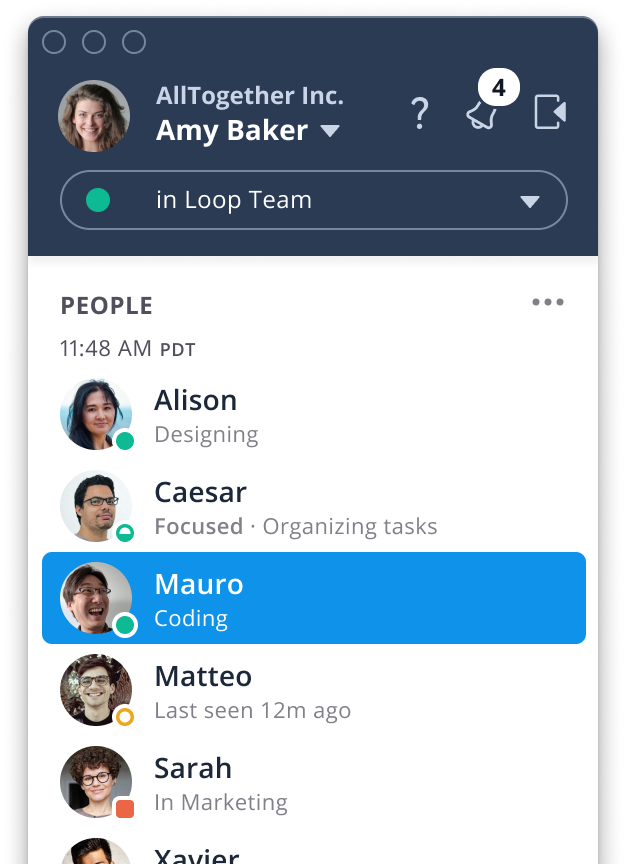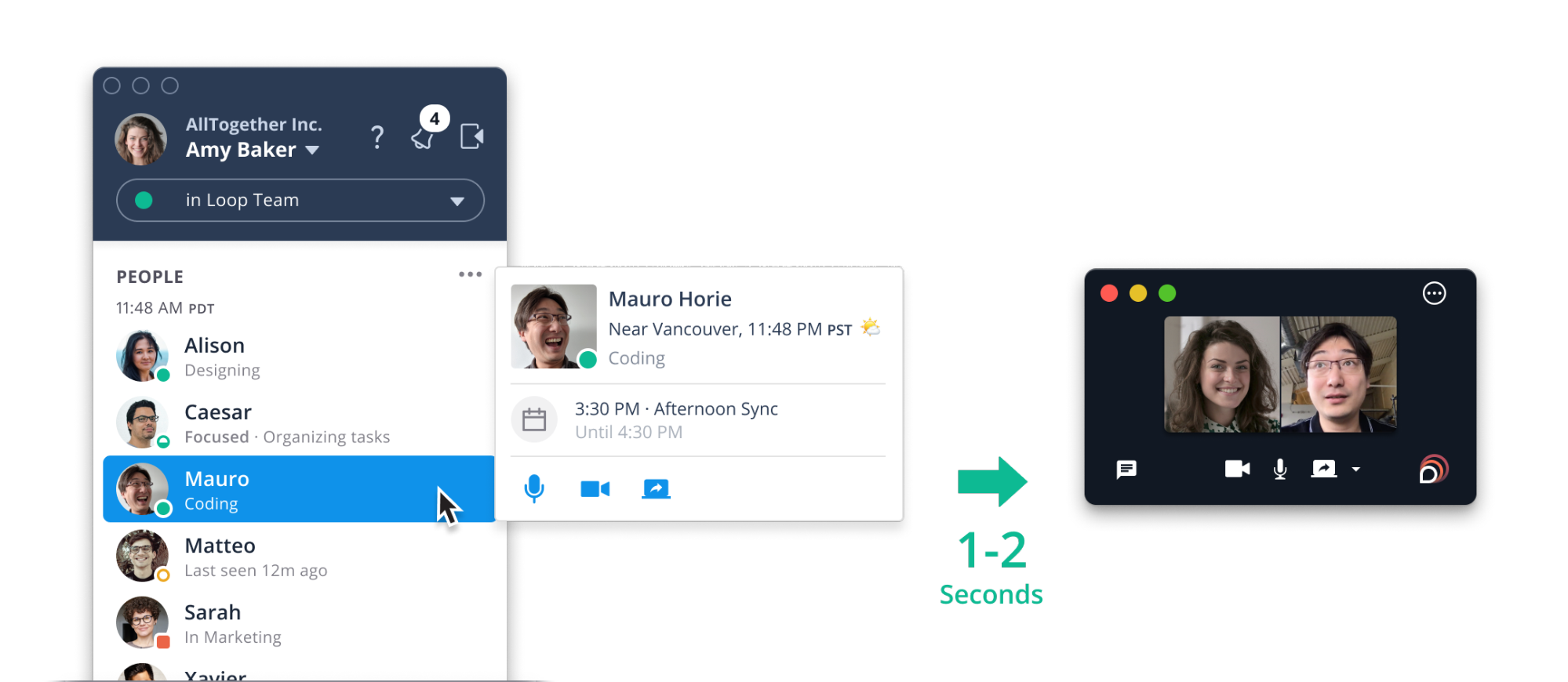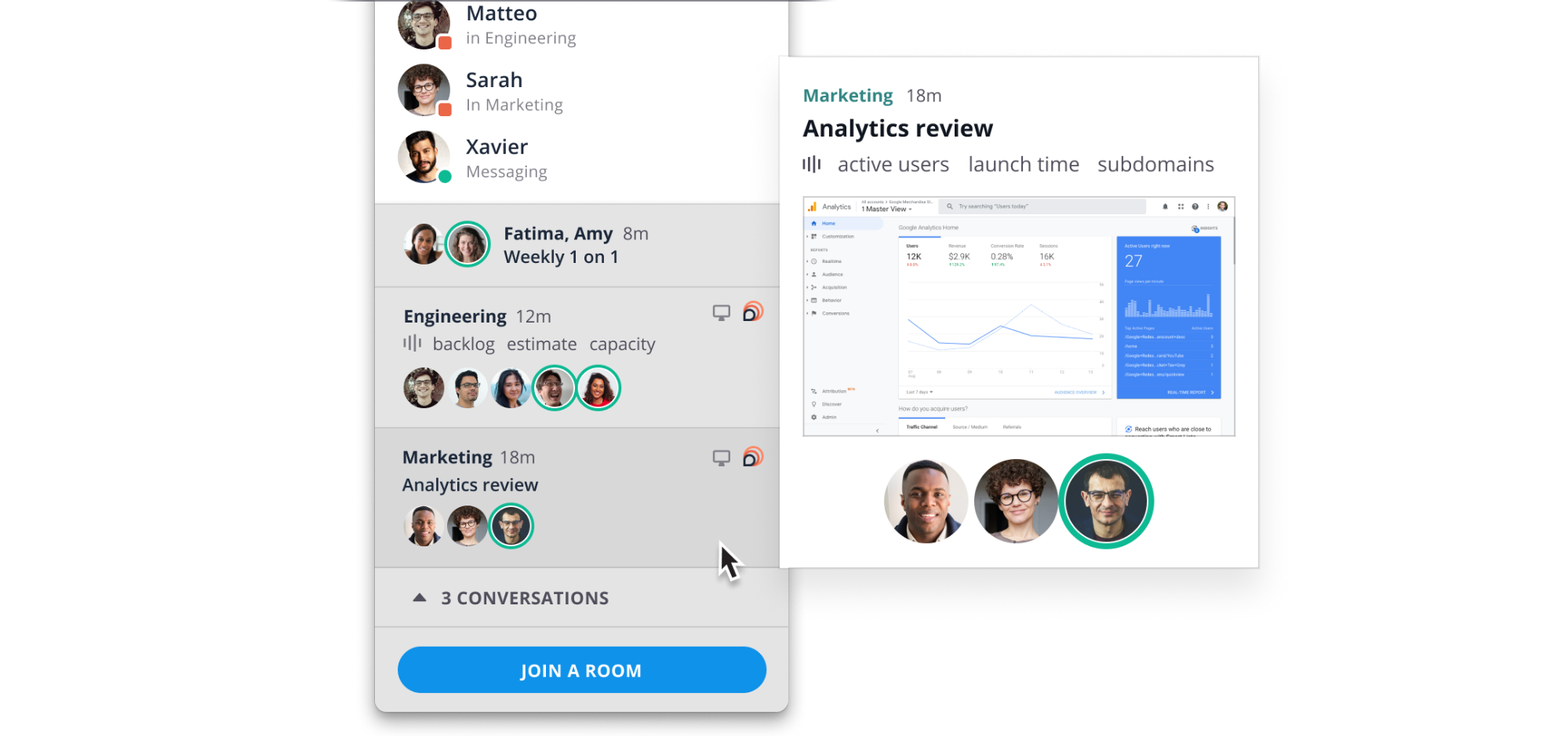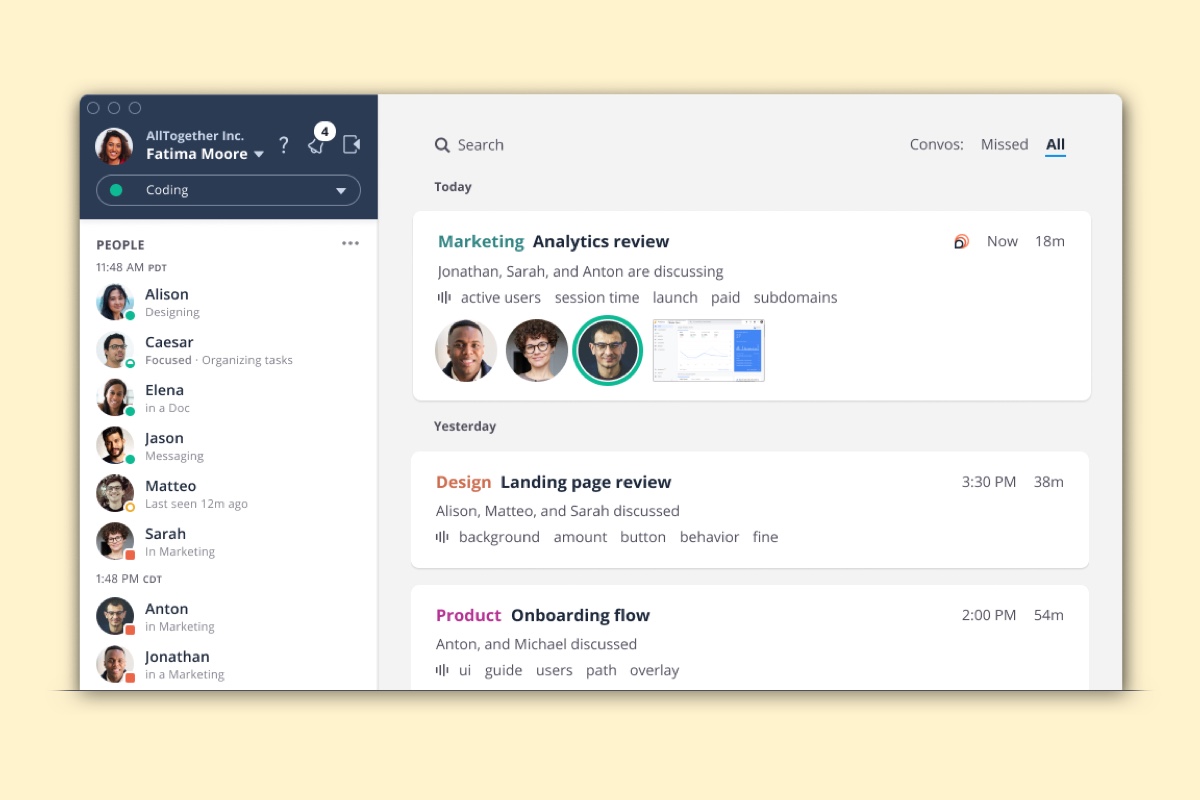Loop Team is aiming to create a safe haven for all hyper-collaborative teams that are looking to bring back some of the in-office behaviours to their new remote work setups. As a virtual office, they are making it easier for folks to understand who is around, what they are doing right now and provide an interface to get in touch and collaborate quickly.
"We are looking to replicate the positive aspects of an office"
Hey Raj! Thanks for sitting down with us! You are the CEO of Loop Team, can you tell us more about what you do?
Sure, Loop Team is a virtual office for distributed teams. We try to bring the best parts of office IRL (in real life) to distributed teams. We interviewed 100s of remote workers in different company configurations (e.g. co-located, partially distributed, fully distributed etc) and we found common pain-points. For example, remote workers often complained of being lonely, feeling out of the “loop,” not getting a sense of who is actually around, what people are doing or have recently done, or just simply missing a lot of relevant discussion because they are distributed and when across multiple time zones, it’s even worse.
To address this, we looked at positive aspects of in-office behaviors and tried to replicate it virtually. So for example, in Loop Team, you can get a quick sense of who is around, who is talking to each other and who is in focus -- this replicates the in-office feel where you can kind of scan the room and get sentiment on someone’s mood when they walk-in in the morning, recognize when someone is in deep work and/or open to engaging and even sense when someone might return when they step out of the office. We simulate that by predicting when someone might return.
 Loop Team's collapsed view highlights your team organized by time zones and automatically identifies who is focused.
Loop Team's collapsed view highlights your team organized by time zones and automatically identifies who is focused.
Taking this further, when you’re in an open office, there is a ton of ad-hoc discussion, collaboration and background conversation. You may be sitting at your desk, have a quick question, and look over and ask your colleague -- that collaboration is instant and fast. You may also later be working through some email and hear a conversation in the background and then maybe jump-in, or at a minimum, gain some context you otherwise would not have had. All of this is lost when distributed.
We try to recreate some of this by making shoulder-tap conversations really fast to encourage quick, informal discussion when you need it. We also allow remote team members to go “live” with their conversations meaning other team members who are not in the conversation can follow topics being discussed in real-time to see if something perks their ears (or eyes in this case). And then after the conversation is over, the remote worker can publish the conversation into a feed so those team members who may have missed the discussion can get context. It’s not replacing published meeting notes by any means, but it provides another opportunity to make all team members feel more included and just simply more in the “loop.”
Why did you decide to work on this?
My last company, Tempo AI, was a partially distributed team. We had an HQ in Menlo Park in California but we had full-time remote team members working from home in Denver, San Luis Obispo, Seattle, Nashville, Argentina, India and other cities. After we were acquired by Salesforce and after I had left, I would check-in with some of my former team still at Salesforce and ask them how things are going. All of them would say that they felt “out of the loop” as compared to when they were at Tempo. I would ask them why and they said that they were often forgotten or just not included and so they would fly to the Salesforce office for one week every month.
I started thinking about what we were doing differently when we were a startup before we were acquired by Salesforce. We used to ship a second device to every team member when they joined, usually an iPad and we ran a 24/7 Hangout in the room. We asked everybody remote and/or anyone working from home to sign into the Hangout. Yes, some new hires felt that it was a bit invasive at first but they quickly grew to really like it because you can see and hear all the discussion in the office. You were completely connected and in the loop.
As the team started to grow though, it didn’t scale very well. We were no longer in one room at the office and there would often be 10+ people on the Hangout meaning everyone had to mute because there was simply too much cross-chatter or more. With Loop Team, I tried to apply some of these learnings amongst others and bring a better experience to make distributed teams feel more connected. You can’t replace the real-life in-office camaraderie but hopefully you can come close to it.
Which kind of remote teams are best suited for Loop?
Loop is trying to recreate the hyper-collaborative feel of small teams who work tightly together in an office. Even in larger organizations, they may often orient the physical spaces to group people together who are working on the same project. Recognize that post-COVID distributed teams, which are now much larger segment than pre-COVID distributed teams, tend to be only distributed across a few timezones. Unlike a Basecamp or Automattic, these teams are maintaining their primarily sync workflows as they had in the office because they can.
We find our greatest success with groups typically 3 to 15 people who hyper-collaborate. This can be a group of ICs (independent contributors) such as engineers within a larger organization or a group of designers, product managers, accountants or even an entire small startup.
Much of the usage is the hyper collaboration that happens between your formal meetings; what we like to say when the real work gets done. Pre-COVID, there were a handful of teams larger than 100 employees that were fully distributed and they were pretty much all in the tech sector. Post-COVID, the world has changed and it’s everywhere.
Our customers have grown from primarily technology companies to all segments. For example, we have an Ops team that uses Loop at a University. We have a group of accountants who use Loop within their consultancy. We have non-profit organizations that are using it to hyper collaborate. It’s been amazing to see the adoption extend beyond early-adopter tech to the broader industry.
How is Loop Team different from big players in the space like Remo or Pragli?
So post-COVID, all things remote have accelerated. Remo is a virtual events tool, amongst others like Airmeet and Hopin. They are focused on recreating physical conferences like a CES but virtually. We share some underlying tech but they are for a different use case, mostly focused on broadcast video as well as facilitating ways to network with other attendees.
Pragli is more similar to what we’re doing but has taken a slightly different approach. That said, I do think the space is large enough that there will be multiple winners. Pragli puts a lot of emphasis on large avatars which I think is fine and maybe better suited for use cases like classrooms. The thing with virtual office is there are two goals: one, improve my workflow so I can get more work done and two, make me feel more connected. Figuring out the UX to balance these two things is the trick. With Loop Team, we feel we have best achieved this balance but we also feel that we have better represented the benefits of office IRL as compared to any other in the category.
For example, things like predictive return based on when you normally come back online or real-time summarization of conversations to recreate the feeling of background conversations which uniquely leverage our background in AI. We even built a model to predict when we think you are really focused; you can certainly update your Slack status every 10 minutes but updating your status all the time sucks especially at home where the data shows people take more breaks.
We also thought deeply about the needs of globally distributed teams and so our Facebook-like feed serves those teams because it allows conversations to be published with smarts that we layer on top of it. Much of these smarts come from our background and also being accelerated out of SRI (Stanford Research Institute) where Siri, Nuance and other great technology has come from.
"Virtual offices sit between Slack and Zoom"
What’s the benefit of a virtual office over a Zoom call?
Pre-COVID, we were asked this question frequently. Interestingly, post-COVID, decreasingly so. I think teams are recognizing themselves that Zoom or Meet or other are great for their large formal meetings but because of the friction of getting a discussion started and the rigidness of the experience, team members are leaning on other tools to have quick, short, frequent more informal discussions for real collaboration. This is actually validated in a recent research report from Microsoft where they found their teams since COVID to be having significantly more short-form, quick discussions and that larger meetings have actually declined in participants and duration. Also recognize that virtual office tools are focused on synchronous communications for your team and by focusing on only your team, there is a lot of opportunity to enhance the experience by integrating with other workplace tools such as Jira.

Loop Team lets you connect and collaborate in 1-2 seconds.
The better comparison is probably Slack. In our opinion, Slack has done an incredible job connecting distributed teams through async communication and over recent years, they’ve put more emphasis into their live/sync communications experience but it’s still pretty obscure. Slack doesn’t provide any real semblance of presence, presents more of a phone-dial experience which just isn’t as seamless as a “drop-in” and doesn’t make any attempt at trying to disseminate those conversations across your broader team.
Virtual offices sit between your Slack and Zoom and we have found for many teams that over time, it replaces some of their Zoom usage and even reduces some of their Slack usage which can be increasingly noisy.
How do virtual offices play together with async communication, given that async is such an important part of remote work?
Async communications is absolutely critical but it’s not a substitute for real, live interactions. I’ve seen some teams talk on Twitter about how they run entirely asynchronously and have virtually no meetings. I think this is fine, but I think for the vast majority of companies, this isn’t going to work with the culture they want to build. If you look at any of the handbooks from Invision to Gitlab, most distributed team best practices talk about live video and the need for seeing and hearing people to feel connected emotionally and for productivity gain. As alluded to earlier, the first generation of fully distributed teams were globally distributed with no real primary timezone bands. The COVID generation of distributed teams is different -- they tend to be localized around specific groups of timezones meaning they primarily work in sync and that’s the culture they had previously maintained in-office.
Loop Team is trying to meet this need on both levels. For example, we’ve made it really easy to change your daily photo and effectively meme or Instagram edit to provide new ways to express yourself.
For those globally distributed team members, as mentioned above, we built a personalized feed where team members can publish conversations that we summarize using AI to give you the context you need so you’re more in the loop. This is something we sometimes refer to as async meetings.
What are use cases of virtual offices in largely distributed teams, with members across the globe?
All teams whether within similar time zones or globally distributed can benefit from virtual office. For global teams, they miss-out on a lot of conversations and generally have less context as to what their other team members work on. We address this through our feed of published conversations and also by presenting historical activity. In Loop Team, you can integrate Jira, Github, Trello and more and when you rollover a person, you can actually see an aggregated history of what teammates have been doing within those tools. We’re not enabling teams to play ‘big brother’ by any means -- this is all data that is already available when you go into Jira and look at the activity history. We just cleanly aggregate and summarize it on a per team member basis. It gives you that context you don’t have and really helps you understand what different team members are working on, which was a common complaint that we heard from our interviews of remote employees.
The other thing that we do is our UX is designed with global in-mind. Team members are organized by time zones as opposed to alphabetically and when you rollover a team member, you can see their location, weather in their city, and even be informed if it’s a holiday in their country. All of this provides additional layers of presence and empathy.
In our interview, Sid Sijbrandij of Gitlab was critical about virtual offices and told us it was a problem that doesn't need solving. What do you respond to that?
I don’t know Sid but I’ve certainly read much of the Gitlab’s remote work content. I have a few comments that might be helpful here. First, Gitlab has been doing remote for a long-time. They’ve obviously established a range of different tools and processes to make it all work and they do it well. They are also a globally distributed team with no real center of influence which forces more async. That said, most companies are new to fully distributed or have only recently embarked on this journey in the past few years which leads to my next point.
We find amongst many distributed teams, there are a handful of hacks being employed to bring them together and make them more connected. We have spoken to teams that are running 24/7-like Hangouts like what I did at Tempo using a Facebook Portal device or other. We have found other teams using Discord and creating fixed office hours where everyone needs to be online. We met one team that uses WhatsApp groups for their faster ad-hoc live conversations. The fact that there are so many different hacks in how teams are trying to piece this together, therein lies the opportunity to productize and package it together.

In addition to people presence, Loop Team allows for real-time conversation presence just like a background conversation in an office.
I think my third point is really just about the virtual office space. Some users have defined virtual office by the initial features that were highlighted by the earliest companies to launch. Unfortunately, we feel those companies got it wrong and way over-stepped on privacy by doing things like sharing precisely what users are browsing at any given moment. In a real office, you can probably see other people’s monitors and tell that they are in Google Docs, but you definitely can not tell what exact doc they are in. We’ve stayed entirely away from this and are building an experience that remote workers love and not feel like they are being spied on.
"COVID has accelerated remote work by 10 years"
How do you think remote work is going to change from the status quo today?
As you can guess, COVID accelerated remote work 10 yrs in 4 months. I think initially companies were rapidly experimenting and thinking of distributed work as an interim thing. As these companies now realize that remote is here to stay, and see that their teams are still being productive, - if not more productive; and as employees report being more happy, they are now going through a phase of making more permanent changes to their workflows, tools and processes to support.
However, even with all of this, nothing beats live in-person interactions. As such, most organizations are exploring hybrid models where their teams can work remotely 2-3 days a week and come to the office 1-2 days a week. In this model, there is still plenty of opportunity to meet, collaborate and build team camaraderie while also allowing the benefits of remote work, like flexibility, eliminated commute times, and more uninterrupted focus time.
The scenario I’m more worried about are companies like Twitter and Facebook that have both announced making remote a larger percentage of their workforce. In this model, there will be an office and there will be full-time remotes. This is the hardest configuration as the remote workers are definitely disadvantaged. Several remote workers have discussed how difficult it is to get promoted when remote. I think it’ll be important to watch how this plays out but there is a real scenario that many of those remote workers ultimately return to the office.
Smaller organizations though, pretty much across the board, are either moving fully distributed or into a hybrid model. This is what I am seeing amongst all of our sister companies across our investors.
What’s the next big goal for Loop Team?
A common behavior we see is that remote workers may set up multiple workspaces. They may be working on 3 different projects at the same time so they need to switch or other. We’re spending some time thinking about what is the best experience to support larger organizations within the same workspace with Loop Team.
Additionally, a lot of recent data indicates broad support for remote work from the employees but less-so from the managers. This is probably because managers are responsible for making sure information is disseminated, people are talking to each other and are used to having the privilege to be able to drop-in on a team member physically throughout the day. Some are also operating as pseudo hall-monitors and micromanaging, not something I purport but I do understand every company culture is different. I think a good next step for Loop Team is to see if there are specific pain-points for managers that we can also address while still primarily serving the individual contributor.

